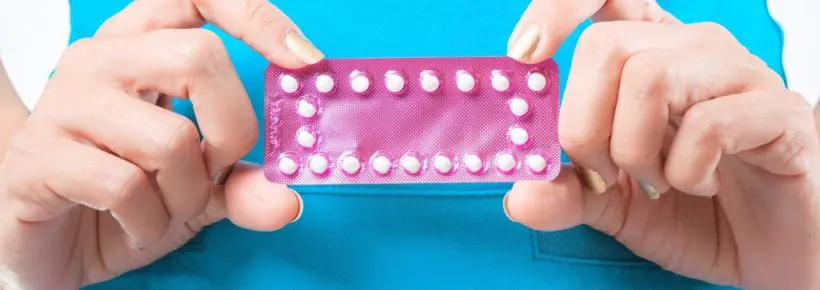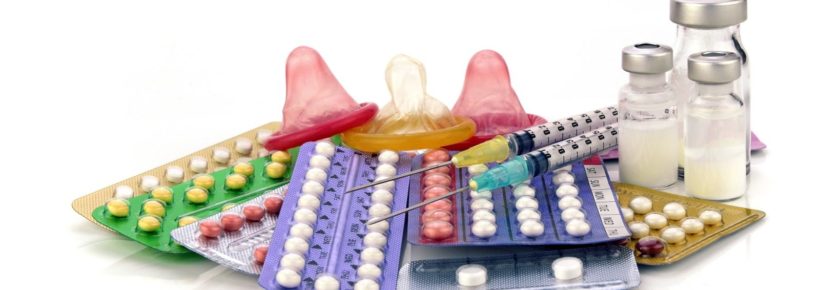Have you ever stopped for gas and watched a giant ten-wheel fuel tanker rumble up to refill the gas station’s tanks? These trucks are enormous, forty feet long, and each carries enough gasoline to fill a small backyard swimming pool.
The powerful hormones in abortifacient methods of birth control dictate their modes of operation. Every year, women in the United States ingest enough of these hormones to fill one of these tanker trucks ― 3,290 gallons (12,500 liters) worth.1 Now imagine a long line of tanker trucks parked bumper to bumper and stretching half a mile. If they were all filled to the brim, they would represent the amount of powerful birth control hormones women have ingested since 1960 in the United States alone.
Birth Control Is Poisoning Our Ecosystem
The serious physical side effects inflicted upon women by the Pill, the patch, injectables, implants, and hormone-loaded IUDs are well documented. But the harmful impacts of birth control extend far beyond the boundaries of women’s bodies.
Environmentalists tell us that our ecosystem depends upon an extremely delicate balance of a large number of factors, and that even the most apparently insignificant activities of man are enough to have major impacts upon it.
Yet they are dead silent on the ecological effects of some of the most powerful chemicals on earth.
Twenty years ago, the United Kingdom’s Environmental Agency stated: “Estrogenic steroids ― natural and synthetic hormones in sewage effluent ― have been shown to be more potent than previously thought, with the synthetic steroid 17a ethinyl estradiol showing effects in fish at concentrations below 1 nanogram [one billionth of a gram] per liter.”2 These findings were confirmed in a 2020 study which also found that some streams had an ethinyl estradiol concentration of more than 60 nanograms per liter, far beyond the limit that causes grave harm to fish populations.3 This means that the problem of hormonal pollution is longstanding and causing ever more severe environmental impacts with each generation of fish.

Another 2020 study conducted in a laboratory in order to precisely control all inputs found that a few picograms [one trillionth of a gram] per liter of water caused malformations, decreased egg production and DNA methylation, which represses gene transcription.4
To visualize the scales we are talking about, a single drop of one of these steroids pollutes 66,500 gallons of water severely enough to cause significant health problems in fish at a concentration of one part per billion. This is equivalent to ten drops in a standard Olympic-sized swimming pool of 660,000 gallons. A single thimbleful would have major impacts on fish living in a lake 300 yards in diameter.5

This is because excreted birth control pill hormones are a pollutant, just like trenbolone (a synthetic steroid that “bulks up” cattle) and the pesticide bifenthrin. Gord Miller, Ontario’s environmental commissioner, said, “If you were designing the perfect pollutant, it would probably look like a pill.”6
Estrogens which are excreted into the environment are classed as endocrine-disrupting chemicals (EDCs) because they interfere with the endocrine systems of both humans and animals. Other EDCs, such as those that find their way into the environment from vehicle exhaust, paints, plastics and adhesives, can be filtered out in wastewater treatment plants, but estrogen-based EDCs cannot, and thus pose a greater threat.7 While municipalities that operate water filtration plants insist that there is no threat to the environment, they cannot explain why the reproductive lives of multiple fish species are being dangerously altered.
The top environmental agencies in the United States, Canada and England have all found that exposure to unmetabolized birth control hormones has caused feminization of male fish, delayed reproduction in female fish, and damaged the kidneys and livers of fish of both sexes.8 Studies have found that female fish outnumber male fish in streams by a ratio of ten to one in areas where there is a high incidence of birth control pill usage. Biologist John Wooding said about this finding, “It’s the first thing that I’ve seen as a scientist that really scared me.”9
One study in New Brunswick by the Canadian Rivers Institute found that entire species of fish were exterminated in a large lake because all of the male fish had become feminized. Study leader Dr. Karen Kidd said, “What we demonstrated is that estrogen can wipe out entire populations of small fish ― a key food source for larger fish whose survival could in turn be threatened over the longer term.”10
These effects of birth control are not limited to fish ― they happen to large mammals as well. A study by the University of Aberdeen found that sheep that grazed on land fertilized with sewage sludge had a high rate of abnormalities in the testes, ovaries, uteri, brains, and thyroid and adrenal glands. These problems were attributed to the high levels of artificial hormones found in birth control pills that cannot be removed by wastewater treatment processes. The study authors warned:
These chemicals are in our air, soil and water. Some are fat soluble and may accumulate in our bodies while others are water soluble and end up passing through us and being flushed down our toilets, entering our environment where they may affect other animals or enter our food chain re-exposing humans.
Many of the changes we see are very subtle and not apparent in the living animal; nevertheless, they may be associated with disruptions of many different physiological systems and increased incidences of diseases and reproductive deficiencies such as those that have been reported in a variety of species, including humans. Embryos, fetuses and young animals appear to be particularly vulnerable.
It’s notable that incidences of breast and testicular cancer and of fertility problems in humans are increasing, while populations of animal groups as diverse as amphibians and honeybees are in decline.11
Why Don’t We Hear of The Environmental Effects of Birth Control?
The environmental effects of hormonal birth control have been suspected for more than two decades, yet environmentalists are completely silent on this issue.
If there is the slightest theoretical chance bird eggs might be damaged or thinned by pesticides, the environmentalists’ outcry is immediate and forceful (recall the propaganda campaign regarding DDT). But let the top environmental agencies from several nations definitively document the link between birth control pills and ecological damage, and all we hear from “progressive” groups is … silence.

This is because “progressives” hold “reproductive rights” above all other considerations ― the right to life, free speech, and even our environment. As Betty Ball of the Rocky Mountain Peace and Justice Center said, asking people to stop polluting water with hormones “gets into the bedroom.” She said, “I’m not going there. This involves people’s personal lives, childbearing issues, sex lives and personal choices.”12
And Curt Cunningham, water quality issues chairman for the Rocky Mountain Chapter of Sierra Club International, said that people “would not take kindly” to the suggestion of banning or restricting hormonal contraceptives. He added, “For many people it’s an economic necessity. It’s also a personal freedom issue.”13
In other words, “progressive” activists consider their birth control pills, morning-after pills and abortion pills to be so important that even the environment must take second place to “sexual freedom.” Such is the self-centered and hypocritical nature of the culture of death.
The attempts by pro-lifers like Jill Stanek to sound an environmental alarm have been met with silence, denial, and accusations of hypocrisy. The Left employs its usual tactic of suppressing the point so vigorously that anyone who brings it up will be so ruthlessly stigmatized that people will learn that it is unacceptable to bring up the issue in polite [“progressive”] company. Another topic we are commanded to avoid is the spectacle of top global warming alarmists (John Travolta, Al Gore, Leonard DiCaprio, Harrison Ford and many others) zipping all around the world in their private jets to attend lavish environmental conferences that are always held in only the poshest cities.
We also dare not mention the Birkenstock-wearing, fair-source, granola-munching, strictly vegan activists who vigorously protest genetically modified foods and hormonal beef additives ― and then, at the same time every day, pop a powerful steroid pill.
We Drink Estrogen-Polluted Water
Although birth control hormones in the water are not as dangerous to human beings as they are to fish, we must note again that sewage and water treatment filtration cannot remove all of them from the water we drink.

Studies in the United States, the United Kingdom, New Zealand and Canada have shown that breast development in young girls has rapidly accelerated since the 1960s, probably due to the estrogens in drinking water. Now young girls are developing breasts as early as six or seven years of age, and spokesmen for the medical societies are, for the most part, silent. Marcia Herman-Giddens, adjunct professor at the School of Public Health at the University of North Carolina, said, “My fear is that medical groups could take the data and say ‘This is normal. We don’t have to worry about it.’ My feeling is that it is not normal. It’s a response to an abnormal environment.”14
Dr. Michelle Bellingham of the University of Glasgow is among the growing number of scientists who believe that male fertility is declining because of the estrogens in our water supplies, leading to an increased use of in-vitro fertilization (IVF) and other assisted reproductive technologies.15
Another study by the University of Pittsburgh Center for Environmental Oncology found that chemicals extracted from randomly sampled fish in the Allegheny, Monongahela and Ohio rivers caused growth of estrogen-sensitive breast cancer cells cultured in a laboratory, eleven of which “produced very aggressive cancer growth.”16
One British study found that the incidence of prostate cancer in men is highest in areas where the use of oral contraceptives is the greatest.17 Several such studies are widely varied in their geographical locations and objectives and, as a whole, are not yet conclusive, but their results should concern conscientious scientists and sociologists.
The University of Aberdeen scientists who performed the sheep study darkly warned:
If we do nothing, endocrine disruptors may not only impact human health but all the ecosystems including those on which we depend ― if we compromise soil productivity and sustainability of our agricultural systems or cause imbalance in marine and freshwater ecosystems through damage to populations of top predators, ultimately, we threaten our own survival.18
Conclusion
Virtually every environmentalist group and celebrity is caught up in the cause du jour of global warming. It would be ironic indeed if the end of the human race came about because of the widespread use and effects of birth control pills.

“Fish are really a sentinel, just like canaries in the coal mine 100 years ago,” says Conrad Volz, co-director of exposure assessment at the University of Pittsburgh Cancer Institute’s Center for Environmental Ecology. “We need to pay attention to chemicals that are estrogenic in nature, because they find their way back into the water we all use.”19
“Progressives” push for all kinds of compensation for damage to the environment, the best-known being carbon offsets. Perhaps if a heavy surcharge on the use of birth control pills were levied, people would begin to wake up.
But don’t hold your breath. That idea would actually help the situation — and we can’t have that! After all, if we solved enough of the major crises facing humanity, what would “progressives” have to virtue-signal about?
+ Endnotes
[1] “Fact Sheet: Contraceptive Use in the United States.” Guttmacher Institute, April 2014. According to this source, 9,572,477 women in the United States use the birth control pill, 965,539 use the implant, 1,481,902 use the injectables, 905,896 use the Nuva Ring, 4,452,344 use intrauterine devices (IUDs), 69,106 use the patch, 69,967 use emergency “contraception,” and 375,700 use the abortion pill.
Thus, the total amount of hormones absorbed annually by American women on these birth control methods would be 11,636 kilograms, or 3,290 gallons. (The Facts of Life, Excel spreadsheet F-21-06.XLXS)
[2] March 26, 2002 statement by the UK’s Environmental Agency. Described in “Contraceptive Pill Confirmed as Pollutant, Says UK Environment Agency.” LifeSite Daily News, April 11, 2002.
[3] Latonya Jackson and Paul Klerks. “Effects of the Synthetic Estrogen 17α-Ethinylestradiol on Heterandria Formosa Populations: Does Matrotrophy Circumvent Population Collapse?” Aquatic Toxicology, December 2020.
[4] Bethany M. DeCourten et. al. “Multigenerational and Trans-generational Effects of Environmentally Relevant Concentrations of Endocrine Disruptors in an Estuarine Fish Model.” Environmental Science & Technology, 2020 (Volume 54, Number 21).
[5] “Pill-Popping Society Fouling Our Water, Official Says.” CBC News, March 27, 2006; E. Vulliet, C. Cren-Olive and M.F. Grenier-Loustalot.
“Occurrence of Pharmaceuticals and Hormones in Drinking Water Treated from Surface Waters.” Environmental Chemistry Letters, September 2011, pages 103 to 114.
There are about 15,040 drops of water in a gallon. There are 660,000 gallons of water in an Olympic-sized swimming pool. There are about 20 drops in a milliliter and about ten milliliters in a thimble (See? Your math teacher told you this kind of thing would be fun)! The total amount of 17a ethinyl estradiol in a woman is about 300 parts per trillion of body weight (telephone discussion with Dr. Joel Brind on March 25, 2015).
[6] “Pill-Popping Society Fouling Our Water, Official Says.” CBC News, March 27, 2006.
[7] Thaddeus Baklinski. “Scientists: Harmful Hormones from Birth Control Pill Can’t be Filtered out in Sewage Treatment.” LifeSite Daily News, September 12, 2012.
See also “Can Birth Control Hormones Be Filtered from the Water Supply?” Scientific American, July 28, 2009.
Studies are ongoing, and developments regarding various types of reverse osmosis filtering may remove these hormones from the water we drink. Whether it is economically possible to treat the water that goes into areas where wild fish live is a different story.
[8]“Pill-Popping Society Fouling Our Water, Official Says.” CBC News, March 27, 2006.
[9] “Birth-Control Pills Poison Everyone?: Environmentalists Silent on Threat from Water Tainted with Estrogen.” WorldNetDaily, July 12, 2007.
[10] Canadian Natural Sciences and Engineering Research Council. “Fish Devastated by Sex-changing Chemicals in Municipal Wastewater.” Science Daily, February 20, 2008. Described in Hilary White. “Study Confirms Estrogen in Water from the Pill Devastating to Fish Populations.” LifeSite Daily News, February 18, 2008.
[11] Professor Paul Fowler, University of Aberdeen, Chair of Translational Medical Sciences, and Dr. Stewart Rhind, James Hutton Institute. “Sex and Sewage.” University of Aberdeen, Café Scientifique talk of June 13, 2012. Described in Thaddeus Baklinski. “Scientists: Harmful Hormones from Birth Control Pill Can’t be Filtered out in Sewage Treatment.” LifeSite Daily News, September 12, 2012.
[12] “Birth-Control Pills Poison Everyone?: Environmentalists Silent on Threat from Water Tainted with Estrogen.” WorldNetDaily, July 12, 2007.
[13] Iain Murray. The Really Inconvenient Truths: Seven Environmental Catastrophes Liberals Don’t Want You to Know About — Because They Helped Cause Them (Simon and Schuster, 2008).
Hilary White. “Hormonal Contraceptives Pollute Drinking Water ― Environmentalists Turn a Blind Eye.” LifeSite Daily News, July 11, 2007.
[14] Marcia E. Herman-Giddens, et. al. “Secondary Sexual Characteristics and Menses in Young Girls Seen in Office Practice: A Study from the Pediatric Research in Office Settings Network.” Pediatrics, April 1997 (Volume 99, Number 4), pages 505 to 512.
Described in Hilary White. “Study Confirms Estrogen in Water from the Pill Devastating to Fish Populations.” LifeSite Daily News, February 18, 2008.
[15] Professor Paul Fowler, University of Aberdeen, Chair of Translational Medical Sciences, and Dr. Stewart Rhind, James Hutton Institute. “Sex and Sewage.”
Described in Thaddeus Baklinski. “Scientists: Harmful Hormones from Birth Control Pill Can’t be Filtered out in Sewage Treatment.” LifeSite Daily News, September 12, 2012.
[16] Hilary White. “Hormonal Contraceptives Pollute Drinking Water ― Environmentalists Turn a Blind Eye.” LifeSite Daily News, July 11, 2007.
[17] D. Margel and N.E. Fleshner. “Oral Contraceptive Use is Associated with Prostate Cancer: An Ecological Study.” British Medical Journal, November 2011.
[18] Thaddeus Baklinski. “Scientists: Harmful Hormones from Birth Control Pill Can’t be Filtered out in Sewage Treatment.” LifeSite Daily News, September 12, 2012.
[19] David Biello. “Bringing Cancer to the Dinner Table: Breast Cancer Cells Grow Under Influence of Fish Flesh.” Scientific American, April 17, 2007.
Dr. Brian Clowes has been HLI’s director of research since 1995 and is one of the most accomplished and respected intellectuals in the international pro-life movement. Best known as author of the most exhaustive pro-life informational resource volume The Facts of Life, and for his Pro-Life Basic Training Course, Brian is the author of nine books and over 500 scholarly and popular articles, and has traveled to 70 countries on six continents as a pro-life speaker, educator and trainer.







As the founder of two NFP organisations in the Czech and Slovak Republics respectively, I have seen many fertility charts of couples who wish to avoid or postpone conception. In such cases there is often a flurry of activity at the beginning of the infertile period, which tends to tail off. After all, people actually need to sleep in bed. People are not usually sex maniacs. NFP does not generally require less sexual activity, just different timing.
With NFP there is no polution of the environment!
I appreciate your feedback and questions, Rhonda. I do go for primary sources whenever possible, but not always because it is not always necessary to do so. Perhaps for a scientific article, but not this kind of “pro-life talking points” article. While we could debate whether the secondary sources cited here are inflammatory, it doesn’t make the information presented incorrect.
Also, many of the sources cited are secondary, not primary, from websites known for their inflammatory tone. Why not list the original sources? This is not the most helpful way to present pro-life talking points. Was the purpose to provide thought-provoking tools for people working to bring an end to abortion? Or just to incite hostility against the Left? They seem to be doing a good job of rolling out reasons to be disgusted at them without any help.
There are also thousands of women who take smaller doses of birth control hormones for medical reasons, not for contraceptive or abortifacient use. How much of an impact does that have on the water supply? These are women who would be physically ill one day out of every month. Perhaps there are better treatments for them, but the medical care system doesn’t put that forward, yet. These could easily be pro-life, environmentally considerate women. This article also does not address the possibility of finding new ways to filter waste water. Why not?
Rhoda, thank you for your questions. I can only say that the impact on the water supply would be proportional to the amount of hormones taken, and since nobody knows how many women take birth control pills for medical reasons, we can’t know. Plus, if they take a smaller dose, maybe it is all absorbed. You might contact your local water supply facility to inquire about filtering waste water. And, while we are not experts on water filtration, we would suggest the following link for more information on reverse osmosis filters: https://www.scientificamerican.com/article/birth-control-in-water-supply/.
Statistically, there are enough hormone pollutants to pollute 26,787,200,000,000 gallons of water each year. That comes to 27 million water tanks which hold 1 million gallons of water each.
The article mentioned accelerated breast development but failed to mention that this development is abnormal, producing dense breast material and making the breasts prone to cysts and so forth. These pollutants no doubt also play a large role in the high incidence of breast cancer including metastasis and possibly prostate cancer since among close relatives, these cancers are the most highly correlated of all..
Another point missed is the accelerating incidence of tendency toward homosexuality over the years. If these hormones are trans-sexualizing certain fish species. then what are they doing to the human fetus in the womb of the mother? It is well known that masculinization of the fetus occurs in the womb associated with a biologically timed surge in estrogen. In some species such as rats, all fetuses start out morphologically and psychologically as females. The specifically timed estrogen surge in the genetic males causes them to become psychologically and morphologically male. Artificially blocking this surge produces genetically male rats that look and act like females. If the surge is artificially induced in female rat, they become morphologically and psychologically male rats. It does not take too much imagination to see what this is doing in the womb of the human female to both male and female human beings, and some of these effects are paradoxical and can only be understood with a deeper understanding of the process and what effects partial to complete blocking or activation of the process. In human beings, the morphological characters are specific to male and female fetuses, but the psychological is programmed intrauterine.
If one wishes to delve into the conspiracy theory, one has present in this scenario scientifically verifiable facts that applied to the framework of the fictitious novel by J. Walker Percy: “The Thanatos Syndrome” to see that the mad hounds of birth control could easily poison large segments of society with these noxious toxic chemicals. This is not some weird alien movie, but reality sitting on our doorstep. Why worry about Nuclear and biological warfare. We have birth control that can be produced in large enough quantities to poison the entire human race. There is no control population in this scenario because it effects ALL of us. I do not think Fr. Paul Marx lived long enough to see this scenario although his brilliant insights on birth control are certainly commendable.
Thank you for your valuable comments, Gerard. Good points all!
All the more reason to say grace before and after meals (and add w/ the sign of the Cross on the food, “If the devil is present, may he be cast out, and if The Lord is present, may He stay.”)
How do we protect ourselves from drinking this? I’ve heard that berkey filters remove these, but want to learn as much information as I can about this.
Thank you for your question, Erika. While we are not experts on water filtration, we would suggest the following link for more information on reverse osmosis filters: https://www.scientificamerican.com/article/birth-control-in-water-supply/.
doesn’t the fact that scientific american, which many consider left leaning and an environmentalist friendly publication ,has an article about the negative effects of birth control on our water supply kind of go against your narrative that environmental groups are hiding the truth and there is some kind of cover up?
Scientific American touts itself as scientific rather than political. Of course as with anything read, we must consider author bias and the logic and truth of what is said. If one scientific journal “plays fair” it doesn’t hold that every environmentalist does.